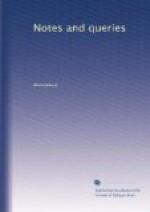Arabic Numerals.—I had replied to “E.V.” (No. 15. p. 230.), when I saw by your “Notice to Correspondents,” that the question was answered. I therefore waited the publication of the replies, which I find do not embrace any one of the points to which I would call the attention of “E.V.”—Diophantus of Alexandria, who flourished about 150 years after Christ, and who wrote thirteen books of algebra or arithmetic in the Greek language, is generally supposed to be the oldest writer on the subject that has come down to our time; but it was not from him that we received the knowledge of algebra in Europe. It appears certain that the first knowledge of this science in England was from Italy or Spain, after the Moors settled in the latter country; and the Arabians and Persians appear to have derived their arithmetical method of computing by ten characters from the Indians: who, in their turn, have most probably borrowed from the Chinese, and improved on their method by the adoption of a zero, which was one of the most important improvements effected by the Hindoos. In China, the words ancient and modern are almost synonymous; their usages and customs being so unchangeable, as appears by their instrument of computation, the swanpan, which is still used in all their calculations. The Oriental scholar will find much curious and interesting information connected with this subject in the Sanscrit Vija Ganita and Lilivati of Bhaskara Acharya: the former was translated into Persian at Agra, or Delhi, in 1634, and the latter by Fyzee in 1587; but there are also English translations, all of which are in the library of the Royal Asiatic Society. The Khalasah-ul-Hisah is another work of repute in India. Mr. Strachey wrote and printed in India, for the Asiatic Researches, a valuable paper, which contains most conclusive evidence of the Indian (if not Chinese) origin of our numerals. See also Astronomie Indienne, of M. Bailly; 2d vol. Asiatic Researches, “On the Astronomical Computations of the Hindoos,” by Saml. Davis; “Two Dissertations on Indian Astronomy and Trigonometry,” by Professor Playfair, in the 2d and 4th vols. of the Edinburgh Philosophical Transactions. And many others might be referred to; but all tending to prove that our numbers came originally from China and India, through Persia, Arabia, Africa, Spain, and Italy, by gradual and successive changes in form, several of them still retaining a close resemblance to the ancient and modern Sanscrit, Chinese, Arabic, Persian, and Hindoo numerals.
Henry Wilkinson.
* * * * *
REPLIES TO MINOR QUERIES.
I send you a few Notes on Queries scattered through some of the later numbers of your very valuable publication:
Anonymous Ravennas.—In the library of the Royal Geographical Society, I believe there is a copy of an 8vo. edition of that cosmography.




